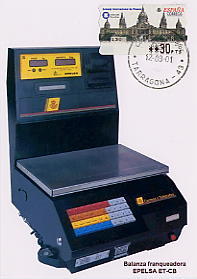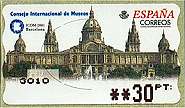Up to December 2001, there existed up to 6 ATM printing varieties for each paper or design of label that appeared on the different franking balances (EPELSA or MOBBA) used, and the various fonts that occurred on the ATM, for the printing of the face value. It's possible to consider that the two variations of 6 digits are simply extensions of those with 5 digits, because both come from different configurations of the same machine model (EPELSA ET-RL). In general, the most difficult variations to obtain are those from the MOBBA machines and the EPELSA ones of 6 digits, which is consistent with the reduced number of machines in use with this configuration.
There are two printing prototypes of MOBBA machines with 5 digits for the face value. Both machines were in service only in 1994 for a short time. See also the 1st older printing variety EPELSA without asterisks.
Correos y Telégrafos (Spanish Posts) decided initially on the advanced introduction to Euros on the 1st September 2001 (later delayed to between December 22 and 28th, 2001) at all Spanish Post Offices. From May and until August 2001 they added important modifications and adaptations in the postal equipment, especially the adjustment of the print head assembly in all the franking balances EPELSA ET-RL(IRIS) to allow their immediate change to the Euro when a changeover date was decided. 9 Post Offices in Madrid, (later enlarged to include other post offices around the country), were selected to adapt their franking balances to Euros, as a initial test. The most obvious modification was the reduction of the number of digits that appeared in the face value printed on the ATMs from the 5 or 6 initially used, to 4, since the maximum face value available would be limited to 99,99 €. Then, the franking balances printing 5 or 6 "narrow or small" digits, printed 4 "narrow or small", and likewise the 5 or 6 "wide or large" digits, would become 4 "wide or large" ones. This is the origin of two new printing varieties.
In the early days of June, the Spanish Post managers and the company in charge of carrying out the changes in the balances, discovered that this modification assumed that all the ATMs issued in Euros and with a face value higher than 9,99 € (or 999 Pesetas before the change) would not include the security asterisks in front of the face value, which constituted a problem of security against fraud. For this reason they decided again to readjust all the adapted franking balances so as to restore the 5 or 6 initial digits. Thus, the ATMs obtained during this short period, with the printing varieties 4 wide and 4 small, coming from EPELSA ET-RL franking balances, would be considered as authentic curiosities or rarities in the history of the ATM collecting in Spain. (NOT to be confused with the printing errors ! ). From August 2001 and to the end of year, important modifications were made in to the computer system, IRIS, and the EPROM memory, used in the EPELSA ET-RL(IRIS), leaving them ready to work in the new currency at the moment at which the postal Authorities decided. This adjustment included the data printed onto the ATMs, the receipts and all the countable and security processes of the balances. As a result of this adjustment, almost all balances were progressively changed to print in 6 digits for a short period. From December 22 to 28, 2001 all the Spanish Post Offices changed in advance to Euros (La Coruña - 22nd, Sevilla - 24th, Bilbao - 26th, Barcelona and Granada - 27th, Madrid and Girona - 28th, ...). During this period all the offices begin to issue stamps or ATMs with the face value only in Euros (€), progressively, and without previous notice, from a direct order sent out by computer from the Madrid postal authorities. Old independent franking balances type MOBBA and EPELSA ET-CB were replaced by the new model EPELSA ET-RL/T; some of them continued in use issuing ATMs in pesetas in some cases until December 31st (and until January 2002 in St. Julià, Andorra !!). From the January 2nd. 2002, for each model of ATM used in the post office, there exists up to 4 printing varieties, depending on the EPELSA franking balance used, but especially on the configuration of the print head assembly fitted and the impression it makes on the ATM in the face value area. The two variants of 5 digits are the most common, whereas the two variants of 4 digits are extremely rare, because of the greatly reduced number of franking balances in use with this configuration.
(*) For the advanced collector, we can distinguish a sub variant of the 5 small digits printing, differentiating the ATMs issued by balances EPELSA ET-RL and ET-RL/T, according to the separation between the digits corresponding to the number of the balance and the first asterisk before the face value. The differences can also be appreciated easily in the adjust labels.
© J. Jove - M. Sans. ATEEME. Variable value stamps study group All rights reserved. This page was created in 1999. Last updated: 28.09.04 . English edition rewrited by S. Goodman (08.04) |
||||||||||||||||||||||||||||||||||||||||||||||||||||||||||














